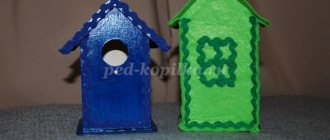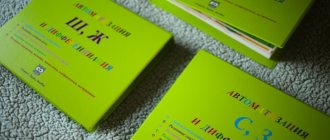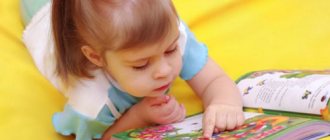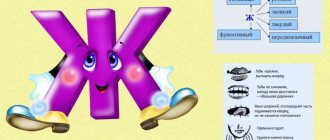Visual and didactic manual on sound automation [C] “Interesting cards”
Galina Kostyuk
Visual and didactic manual on sound automation [C] “Interesting cards”
Automation of assigned sounds is a very important and responsible stage in correctional and speech therapy work to eliminate sound pronunciation disorders. For many children, unfortunately, for various reasons, sounds are very difficult to automate. The use of visualization in correctional work contributes to the formation of children’s interest in classes, and gaming techniques stimulate the mental activity of speech-language pathologist children, thereby contributing to the achievement of the desired results.
I made this manual using the picture designer from the Mersibo development portal. It consists of 4 cards of A-4 format. On the front side there is a house and pictures that “live” in this house. On the reverse side there is a description of the game exercises used in working with this manual. I selected the pictures in such a way that the words did not contain hissing sounds and a minimum of sonorities. Speech therapists and speech pathologists know that this fact contributes to a more successful process of automating whistling sounds.
Visual and didactic aid “Interesting cards”. Automation of sound C.
Target:
Automation of the sound C in words, in sentences; development of phonemic perception, grammatical structure, coherent speech.
Card No. 1 Automation of the sound C at the beginning of a word.
Game exercises:
“Repeaters” The child repeats the names of the pictures after the adult (sun, plane, dog, salad, owl, fireworks, scoop, saxophone, boots, nightingale, catfish, salt shaker, elephant, pig, soup, bough, chest, juice, table, chair, glass, beets, plums).
“Name the object and get a chip” The child names the pictures independently and receives a chip for pronouncing the word correctly.
“Hide and seek” The child closes his eyes, the adult covers several pictures with chips. The child opens his eyes and names the pictures that are “hidden.”
“Name the furniture” (transport, pets, greenery, birds, etc.)
"Who has a tail?" Child: The dog has a tail, etc.
“One is many” 1st child (or adult) - airplane, 2nd child - airplanes, etc.
“What words live in the house?” The adult closes the card, the child names the words that he remembers.
“Telegraph” The child divides words into syllables (claps, taps, lays out with chips).
“Continue the sentence” The adult says the beginning of the sentence, the child finishes. For example: (an airplane is flying high in the sky). Delicious (juice) was poured into a glass. An empty glass was placed on the table, etc.
“What is between, what is” The child makes sentences according to the model: The plane is between the sun and the dog, etc.
“I don’t have something, but I have something” 1st child (or adult) - I have the sun. 2nd child - I don’t have the sun, but I have a plane, etc.
“Make a sentence according to the model” Sample: The owl sleeps during the day, and the nightingale sings, etc.
Card No. 2 Automation of the sound C in the middle of a word
Game exercises:
“Acquaintance” The adult invites the child to get to know the “residents” of the house and determine the common sound in all words, as well as the place of the sound in the words, paying attention to the color of the roof, the letter and the windows.
“Repeat” The child repeats the names of the pictures after the adult (fox, wasp, braids, beans, wheel, mustache, watch, dishes, beads, braid, sand, donkey, swallow, wasps, stork, popsicle, leaf, bridge, football player, cabbage, wheels).
“Name the object and get a chip” The child names the pictures independently and receives a chip for pronouncing the word correctly.
“Name the animals” (birds, insects, garden tools, etc.)
"Who has a tail?" Child: The fox has a tail, etc.
“One is many” 1st child (or adult) is a wasp, 2nd child is a wasp, etc.
“What words live in the house?” The adult closes the card, the child names the words that he remembers.
“Telegraph” The child divides words into syllables (claps, taps, lays out with chips).
“Continue the sentence” The adult says the beginning of the sentence, the child finishes. For example: We saw a cheat (fox) in the forest. Sonya put on her favorite (beads), etc.
“What is between, what is” The child makes sentences according to the model: The wasp is between the fox and the braids, etc.
“I don’t have something, but I have something” 1st child (or adult) - I have a fox. 2nd child - I don’t have a fox, but I have a wasp, etc. “How many wasps (braids?” Child - five wasps, three braids.
“Pick a rhyme” Adult – fox, child – scythe, wasp, etc.
Card No. 3 Automation of the sound C at the end of a word
Gaming techniques:
“Acquaintance” The adult invites the child to get to know the “residents” of the house and determine the common sound in all words, as well as the place of the sound in the words, paying attention to the color of the roof, the letter and the windows.
“Repeaters” The child repeats the names of the pictures after the adult (bus, globe, forest, plus, tray, nose, belt, pineapple, canopy, compass, coconut, oats, vacuum cleaner, ear, focus, ficus, duchess).
“Name the object and get a chip” The child names the pictures independently and receives a chip for pronouncing the word correctly.
“Hide and seek” The child closes his eyes, the adult covers several pictures with chips. The child opens his eyes and names the pictures that are “hidden.”
“Name the transport” (fruits, plants, etc.)
“One is many” 1st child (or adult) - bus, 2nd child - buses, etc.
“What words live in the house?” The adult closes the card, the child names the words that he remembers.
“Telegraph” The child divides words into syllables (claps, taps, lays out with chips).
“Make a sentence” The adult names a word, the child makes a sentence with this word.
“What is between, what is” The child makes sentences according to the model: The globe is between the bus and the forest, etc.
“I don’t have something, but I have something” 1st child (or adult) - I have a bus. 2nd child - I don’t have a bus, but I have a globe, etc.
“Pick a rhyme” Adult – bus, child – globe (tray – coconut, nose, oats, vacuum cleaner), etc.
Card No. 4 Automation of sound C at the beginning, in the middle, at the end of a word
Gaming techniques:
“Repeaters” The child repeats the names of the pictures after the adult (pineapple, stork, clock, plane, wasp, popsicle, juice, tray, dishes, bus, catfish, owl, boots, wheel, dog, pig, forest).
“Name the object and get a chip” The child names the pictures independently and receives a chip for pronouncing the word correctly.
“Hide and seek” The child closes his eyes, the adult covers several pictures with chips. The child opens his eyes and names the pictures that are “hidden.”
“Name the words in which the sound C is at the beginning” (in the middle, at the end)
“Name the transport” (fruits, plants, birds, insects, pets, shoes, etc.)
“One is many” 1st child (or adult) - pineapple, 2nd child - pineapples, etc.
“Telegraph” The child divides words into syllables (claps, taps, lays out with chips).
“Continue the sentence” The adult says the beginning of the sentence, the child finishes using the words from the card. For example: (an airplane is flying high in the sky). Orange juice was poured into (a glass).
“Make a sentence” The adult names a word, the child makes a sentence with this word.
“What is between, what is” The child makes sentences according to the model: The stork is between the pineapple and the clock, etc.
“I don’t have something, but I have something” 1st child (or adult) - I have a pineapple. 2nd child - I don’t have a pineapple, but I have a stork, etc.
“Make sentences based on the model” Sample: The stork flies and the catfish swims. The dog barks and the pig grunts.
Children are happy to study using these cards, they are interested, hence the name “Interesting Cards”.
Preparatory exercises
Before placing the letter
It is necessary to prepare the baby so that it is easier for him to complete
tasks. The set of
exercises is divided
in stages.
Each stage is played in a playful way.
Don't miss: How to set and fix the sound K and Kь
Breathing exercises
Expert opinion
Margarita Sergeevna S.
Speech pathologist and speech pathologist with 15 years of experience working in various speech correction centers with children of different ages.
Exercises are necessary to develop proper breathing during pronunciation. They will help your baby learn to release a stream of air and control the force applied to do so.
Methods
workout:
- Harmonic. The baby stands up straight and places his palms on his tummy. Takes a deep breath through his nose. Stay in this position for 2-3 seconds. Then he exhales air using the oral cavity.
- Breeze. The lips are pulled out with a tube. They take air into their lungs. The baby is asked to blow hard. You need to put your baby’s hand to his mouth so that he can feel the breeze from the tube.
Take a container with a narrow neck. They ask the child to blow. In this case, the neck of the bubble is located near the lower lip. The correctness of the jet is determined by sound.
Storm.
Tip : The time
to complete each task is no more than 3-5 minutes. To prevent the baby from getting bored with the exercises, alternate them.
Articulation gymnastics
Training the speech apparatus helps to understand how the organs should be positioned during the pronunciation of the sounds S and S.
Options for approaches:
- Naughty tongue. Open your mouth slightly and smile widely. The tongue is placed on the lower lip. Pronounce the syllable “five”. In this case, the upper and lower lips hit the tongue. The exercise is performed gradually, inhaling air. Then leave the tongue on the lower lip without moving for 2-3 seconds. The air stream is exhaled.
- Pancake. The mouth is opened and the lips are stretched into a smile. The tip of the tongue is placed on the lower lip. Stay in this position for 2-3 seconds, and then repeat the exercise 3 times.
- Mountain . They open their mouths and smile. The tip of the tongue touches the back wall of the lower teeth (alveoli). The middle part of the organ is raised as high as possible. Afterwards the tongue is lowered down and relaxed.
Don't miss: What is Su-Jok?
Expert opinion
Margarita Sergeevna S.
Speech pathologist and speech pathologist with 15 years of experience working in various speech correction centers with children of different ages.
You should start gymnastics with simple tasks and gradually move on to more difficult ones.
Important: to achieve positive results, you should exercise regularly, without disturbing the order.
Sound setting [C].
The first stage is preparatory.
Sound production begins with preparatory work, which includes: articulatory gymnastics, development of speech breathing, establishing the level of auditory perception.
The speech therapist needs to know that the child differentiates sounds. If speech breathing is poorly developed, then difficulties may arise during sound production. And, of course, the most important part of preparation is articulation gymnastics. The development of articulation of the speech apparatus is an excellent way to prepare the speech organs.
Examples of articulation exercises for whistling sounds:
1. "Smile." The lips are very stretched in a smile. The teeth are hidden.
2. "Frog" . The child smiles widely. The teeth are visible and closed. Hold the position for about ten seconds and rest. Repeat 5-7 times.
“We imitate frogs,
We pull our lips straight to our ears.”
3. “Brushing our teeth.” Smile, open your mouth slightly, and use the tip of your tongue to “brush your teeth.” We move the tongue along the inside of the lower teeth. It is important that the tongue slides closer to the gums, and not along the edges of the teeth. The jaw is fixed.
4. “Swing” . Smile, mouth slightly open, tongue alternately rises and falls, the tip of the tongue rests on the incisors (upper and lower, respectively).
“The children sat on the swing and flew higher than the spruce tree. On the swing up and down, don’t be lazy about swinging.”
5. “Punish your tongue.” We open our mouth slightly, place the tongue on the lower lip (we try to relax the tongue, remove tension). We begin to spank it with our lips, saying “five-five…..”. You need to hold your tongue relaxed for about 10 seconds. “Clapping” occurs with one exhalation.
6. "Slide". We open our mouth. The tip of the tongue rests on the lower incisors. The back of the tongue is raised up.
7. “The ball is in the goal.” We stretch out our lips with a straw and blow on a “ball” made of cotton wool into an improvised goal. The peculiarity of this exercise: the ball must hit the goal with one exhalation. Also make sure that children do not puff out their cheeks.
Techniques for developing speech breathing can be found in the article “Development of speech breathing in preschool children.”
The time allotted for articulation gymnastics is on average 5 minutes per lesson. It is better to do it several times during the day. You shouldn’t immediately introduce your child to all kinds of exercises. Choose 3 tasks and practice them. Working on the articulation of the speech apparatus is working on the muscles and it requires effort from the baby. Do not forget that all exercises must be performed in front of a mirror so that the child can see whether he is doing the exercise correctly.
The second stage is the actual production of the sound [C].
There are three methods of sound production: by imitation, production from reference sounds, production with mechanical assistance (probes, cotton swabs, spatulas). Often there is a mixed method.
The imitation technique is suitable if there are minor defects in sound pronunciation or the sound [C] is absent. A mirror is required during the lesson, as the child must see your articulation and his own.
- Invite your child to smile widely so that his teeth are visible.
- We tense the tip of the tongue and rest it on the lower incisors.
- Ask your child to blow (on a balloon, into a bottle, on a feather) and you will hear the sound [C]. For preschool children, it is important to have a playful moment.
Labial-dental sigmatism - try to pronounce [S] with lips parted and teeth exposed. The lower lip should not “go” up. You can hold it with your hand. The exhaled speech stream should not go into the cheeks. We practice interlabial blowing (into a bottle, onto a candle). Invite your child to smile and blow - this results in interdental blowing. The next step is to hide the tongue behind the lower incisors.
Interdental and subdental sigmatism. Mechanical action is required. Press the tip of the tongue with a cotton swab and hide it behind the lower incisors. Hold your tongue and ask your child to blow and then say [C]. First separately, and then in a syllable. In the case of hissing sigmatism, interdental blowing is used, “snorting” into the tongue. Then we practice interdental pronunciation [C] of syllables, words and phrases. The tongue should fix the required position. After this, we move its tip behind the lower incisors.
With lateral sigmatism: interlabial blowing, interdental blowing, interdental pronunciation [C] in syllables, words, sentences. Then, using mechanical action, we move the tongue behind the teeth.
Nasal sigmatism. Here you need to develop an air stream in the center of the tongue (blowing on a candle, cotton wool). We start by practicing interlabial blowing, then interdental blowing and pronunciation of [C] in syllables, words, phrases. We move the tip of the tongue to the tooth position.
Setting the sound [C] - “whistle” technique.
There is a technique for setting [C], which is suitable for all types of sigmatism.
Let's call it "whistle". The mechanical effect on the tongue is exerted by the child himself with the help of his finger. What is the essence of this method? The preschooler places his index finger (about 2 centimeters) on his wide tongue, which lies behind his lower teeth. He bites his finger with his upper teeth. Conventionally, he has a “whistle” in his mouth. At the same time, the lips are stretched in a wide smile, in which the teeth are clearly visible. The speech therapist offers to blow on the child. The organs of articulation must remain fixed. With this method, it is better to fix [C] in reverse syllables.
The third stage is consolidation and automation.
Establishing the correct pronunciation of an isolated sound is only the beginning of the journey. Now it is important to automate it. Automation is happening gradually.
Examples of tasks and exercises for automation:
• Syllables for repetition reflected SA - SA - SY SA - SY - SA SY - SA - SY
AS - OS - US US - YS - AS
SVA SMO SPA (choose those sounds that the child pronounces correctly) SVO SMU SPU
• Learning pure sayings. Sa - sa - sa - the wasp is flying. Su - su - su - did you see the wasp? Sy - sy - sy - no wasp. (the child can pronounce the syllables, and the speech therapist can continue the sentence. Then you can switch places).
• “Choose and name.” The preschooler has pictures in front of him. His task is to select and name those that depict food products. (juice, sugar, sofa, cheese, soup, chair).
• Words to repeat reflectively. Juice, Sonya, owl, sock, piece, falcon, forest, voice, wheel, sun, beans.
• “One is many” An adult says the word in the singular, children in the plural). Juice - juices dog - dogs pump - pumps
• “Finish the sentence.” The adult begins the sentence, and the child finishes by finding the corresponding picture.
An owl sits on a branch. (Pine) grows in the forest. Sonya drinks (juice).
• “Call me kindly.” (dog - doggie, owl - owl).
• Working with a plot picture. Select the picture based on the sound you are working on. And ask relevant questions.







